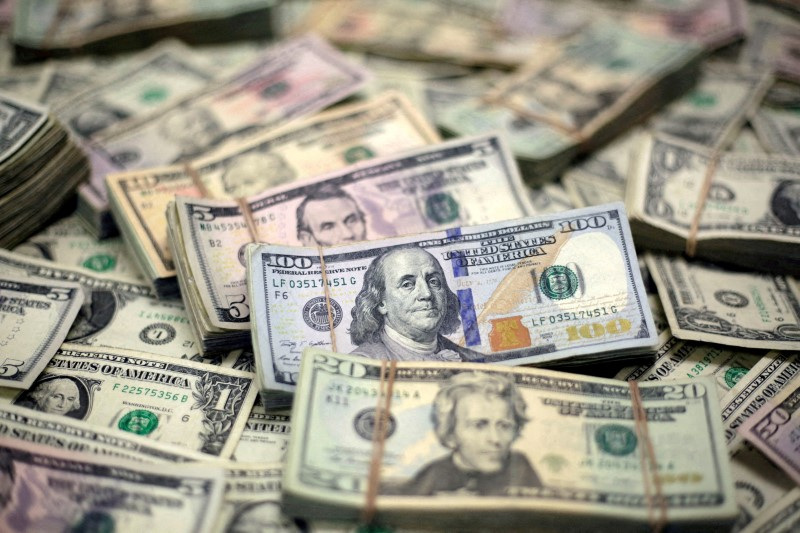Forex
Dollar slips, handing back gains ahead of Fed meeting

Investing.com – The U.S. dollar retreated Thursday, giving up some of its hefty post election gains ahead of the latest Federal Reserve meeting, while sterling rose with the Bank of England policymakers also assembling.
At 05:00 ET (10:00 GMT), the Dollar Index, which tracks the greenback against a basket of six other currencies, fell 0.2% to 104.790, after surging to its highest since early July the previous session in the wake of Donald Trump’s election victory.
The recorded its biggest single-day gain since September 2022 in the previous session.
Dollar retreats ahead of Fed meeting
The dollar surged to a four-month high on Wednesday as the prospect of a Republican sweep in Congress presented a much easier path for a Donald Trump administration to enact his tariff and immigration policies, which are widely seen as inflationary.
This could prompt the Federal Reserve to reduce rates at a slower and shallower pace, buoying the dollar.
“The challenge for investors is how to position now,” said analysts at ING, in a note. “The US election event risk has passed with a surprisingly clean outcome, but Trump’s policy agenda will not emerge until 2025, and perhaps not even until late in 2025.”
For now the attention turns to the latest , which concludes later in the session. Markets have been positioning for another rate cut, this time by 25 basis points instead of the jumbo 50-basis point reduction seen in September.
“We doubt Chair Jay Powell is ready to endorse the market’s less dovish re-pricing of the Fed’s easing cycle by saying prospective Republican policy is inflationary. It would be a bullish dollar surprise if he did,” ING added.
Sterling looks to Bailey’s comments
In Europe, rose 0.2% to 1.2904, with the likely to announce another rate cut of 25 basis points later in the session, its second cut since 2020, after a move in August.
Such a decision would be widely expected, with the topic for debate being whether the policymakers signal further cuts ahead after the government’s inflation-raising budget.
“There is downside risk to UK rates and sterling today if [Governor Andrew] Bailey downplays the significance of the UK budget to the BoE easing cycle,” ING said.
climbed 0.2% to 1.0753, having fallen as low as 1.0682 for the first time since July 27 on Donald Trump’s reelection.
The euro has regained some ground despite the collapse of the German government, with German Chancellor Olaf Scholz saying on Wednesday that he would call a confidence vote on January 15, which could pave the way for a snap federal election in March.
This followed Scholz sacking Finance Minister Christian Lindner of the Free Democrats party after a series of budget disputes, causing the three-party ruling coalition to collapse.
“The prospect of a new German government next March might actually increase the chance of some fiscal stimulus and provide better ammunition for Europe to withstand Trump’s trade agenda in 2025,” ING said.
Yuan gains after recent battering
dropped 0.2% to 7.1609, with the yuan gaining after being battered by the prospect of a Trump presidency, given that he has vowed to impose steep trade tariffs against the country.
The prospect of a renewed trade war bodes poorly for the Chinese economy, but Beijing is also expected to roll out more fiscal stimulus to brace against any tariffs.
The National Peoples’ Congress kicked off a four-day meeting earlier this week, and is expected to outline plans to increase fiscal spending and support growth.
fell 0.5% to 153.94, after the pair hit a three-month high in the prior session, sparking warnings from Japanese ministers over potential intervention.
rose 1% to 0.6631, rebounding from losses in the prior session, with data showing the country’s trade balance shrank more than expected in September amid softening commodity exports.

 Forex3 years ago
Forex3 years agoForex Today: the dollar is gaining strength amid gloomy sentiment at the start of the Fed’s week

 Forex3 years ago
Forex3 years agoUnbiased review of Pocket Option broker

 Forex3 years ago
Forex3 years agoDollar to pound sterling exchange rate today: Pound plummeted to its lowest since 1985

 Forex3 years ago
Forex3 years agoHow is the Australian dollar doing today?

 Cryptocurrency3 years ago
Cryptocurrency3 years agoWhat happened in the crypto market – current events today

 World3 years ago
World3 years agoWhy are modern video games an art form?

 Commodities3 years ago
Commodities3 years agoCopper continues to fall in price on expectations of lower demand in China

 Economy3 years ago
Economy3 years agoCrude oil tankers double in price due to EU anti-Russian sanctions





















